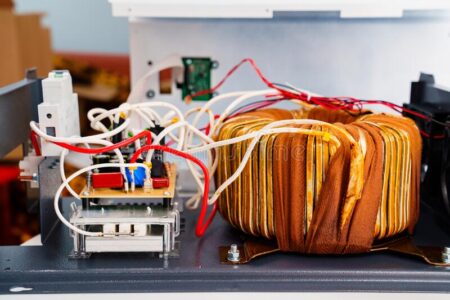Voltage and Current are two terms we frequently use at home. Unfortunately, many people confuse them to denote the same. But are they? Let us discuss voltage and current to understand the difference between these terms.
What is voltage?
Voltage is the electromotive force that drives the current between two points in an electrical circuit. It is denoted by the symbol V.
What is current?
Current is the rate or speed at which the electric charge flows through any particular point in the circuit. It is usually denoted by the symbol ‘I.’

Let us now discuss the difference between voltage and current. This tabular chart should explain things better.
| Parameters | Voltage | Current |
| Symbol | V | I |
| Unit | Volts | Amps |
| Definition | The potential difference between two points in an electrical circuit, also known as energy per unit charge | Rate of flow of the electrical charge past a point in the electrical circuit |
| Relationship | Voltage is the cause, whereas the current is the effect | Current is the effect, with voltage being the cause |
| Instrument for measurement | Voltmeter | Ammeter |
| SI Unit | 1 V = 1 Joule per coulomb | 1 A = 1 coulomb per second |
| Formula | V = W / Q Voltage = Work / Charge | I = Q / t Current = Charge/time |
| Relation | V = R x I Voltage = Resistance x Current | I = V / R Current = Voltage / Resistance |
| Created fields | Voltage creates an electrostatic field. | Current creates an electromagnetic field. |
| Series Connection | Voltage gets distributed over different components connected in series. | However, the current remains the same across all components connected in the series. |
| Parallel Connection | The voltage remains the same across components when connected in parallel. | The current gets distributed between the different components when connected in parallel. |
| Types | Direct VoltageAlternating Voltage | Direct CurrentAlternating Current |
| Produced by | Generator, alternator, batteries | Voltage and EMF |
| Drop or Loss | AC resistance and impedance | Due to passive elements |
| Polarity Changes | Constant in DV and changes in polarity in AV | No change in polarity in DC, whereas it changes in AC. |
| Existence | Voltage can exist without current because it is the cause of the flowing charge. | Current cannot exist without voltage because voltage causes a current flow. A notable exception is a theoretical superconductor. |
| Circuit | Voltage does not need a circuit. Two points with a potential difference are sufficient for voltage. | Current needs the completion of a circuit to flow. It cannot flow without a circuit, even if there is voltage. |
Final Words
We have discussed the concept of voltage and current and understood the difference between the two terms. Thus, it should help us understand our domestic electrical appliances better.



